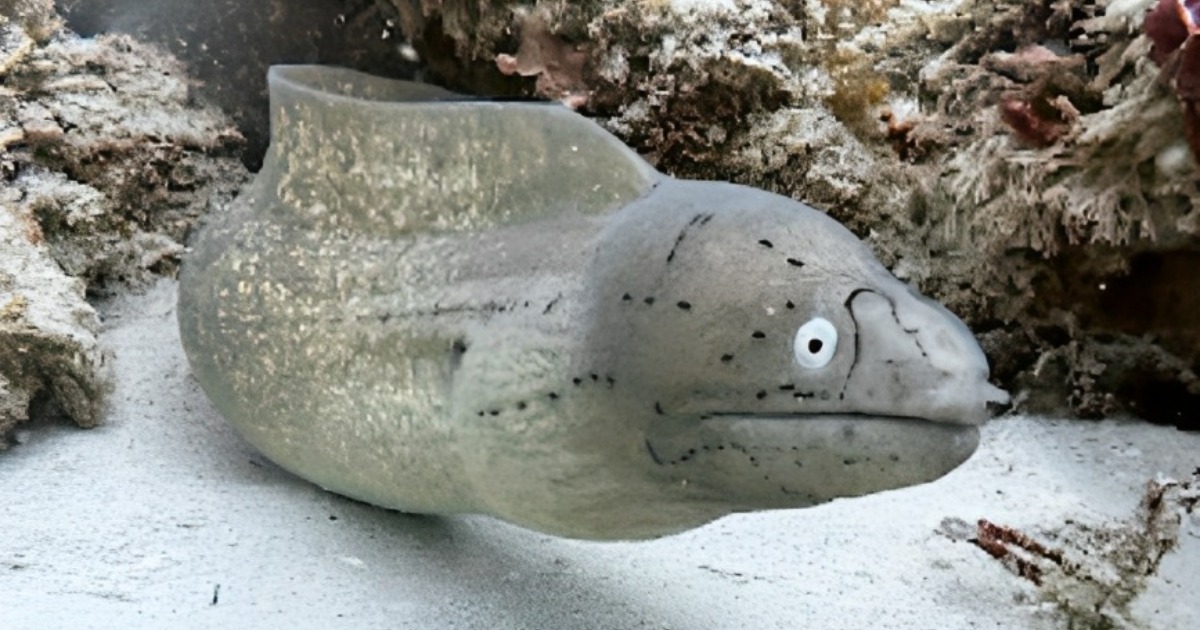To eat a fish you caught, you must first incapacitate it, and it seems that’s not always easy, especially when it comes to moray eels. When the fishermen caught this fish, they had no idea what they were dealing with. They tried using a hunting knife, but it didn’t faze the fish at all; it just kept moving as if it wanted to bite its captors.
See that the Moray eel is still moving its jaw, even though it was literally stabbed in the head with a knife, and yet it’s determined to bite those who caught it. It even managed to gulp down its prey; they found a piece of another eel in its throat. Even with a knife in its head, this fish was still breathing when they released it back into the water.
Of course, the most humane way to kill the fish is to stab it in the head with a knife, but the Moray eel has an extremely hard skull as well as very tough flesh. And while no animal can survive brain damage, the Moray eel can surprise us. To just stick a knife into its head, you have to put a huge amount of force; otherwise, you just won’t pierce the skull. Once the knife is in, it’s almost impossible to get it out.
Now, imagine Gollum if he’d caught a Moray eel instead of a regular fish. I get how the knife can get stuck in that super strong skull, but what surprises me is how the Moray eel keeps on moving despite that wound, which should be totally fatal. We have two theories. One suggests that the knife somehow miraculously avoided hitting anything vital in the head. I’m not sure if that’s possible when it comes to the head, but you never know, right?
The second theory about Moray eel
The second theory says that the Moray eel is dead, and the body is moving because of reflexes. Not too long ago, we already talked about how things work in cold-blooded animals, and the Moray eel is one of them. Low temperature allows tissues such as the brain, nerves, and muscles to stay alive for a while before the lack of oxygen kills them. This is what allows signals to travel through the body even if the fish is technically already dead.
No wonder fishermen believe that the only truly reliable and humane way to kill a Moray eel is to cut off its head entirely. Only then can you be a hundred percent certain that the fish is dead. Oh yeah, and you’d need a very sharp knife, probably made of adamantium.
Killing a Moray eel is challenging, and it’s not solely because of their tough skulls. Have you seen how it moves its jaw even as it’s about to kick the bucket? Well, that jaw’s really something to watch out for.
Many fish have a second set of jaws hidden in their mouths, which are supported and controlled by special muscles. The muscles of Moray eels are more like bungee jump cords, giving them the special ability to move their pharyngeal jaws forward and backward rather than up and down. Researchers observe the Moray eel’s pharyngeal jaws extending during feeding and then retracting for swallowing. This unique movement serves an understandable purpose: to grab the food and pull it down the throat into the esophagus. This second jaw is clearly visible in the Moray eel’s X-ray; these bent bones are the jaw.
Moray eels dietary adjustments
Moray eels need these dietary adjustments because they live in tight burrows nestled within rocky crevices or caves, which makes their bodies naturally elongated and slender. In short, without these jaws, the prey would just get stuck in the Moray eel’s throat. Yes, you got it right – evolution gave them extra jaws to keep the fish from choking while eating.
When the Moray eel sinks its teeth into its prey, it unleashes a second set of equally sharp teeth, doubling the impact and making its bite particularly dangerous and painful. Also, the teeth on its pharyngeal jaws have a truly menacing look; no, really, they do look creepy.
The most interesting thing is that the Moray eel doesn’t even need to be completely in the water to swallow its prey. Researchers were amazed when they captured this video because no fish can swallow its dinner while on land. Needless to say, when dealing with Moray eels, fishermen have to be extra careful. As long as the Moray eel has a head, it’s capable of biting you, and it’ll be very painful.
Moray eels have a grip similar to that of a bulldog
Moray eels have a grip similar to that of a bulldog, thanks to their long, toothy jaws that nature designed to firmly hold their prey. Just a few of their teeth sinking into prey is enough to trap it. The good news is that Moray eels don’t usually bite humans; however, the bad news is that when they do, their bite can be compared to that of a fighting dog. Check out two Moray eels in a tussle; they’re really going at each other.
The direction of Moray eel teeth gives them an additional edge. Positioned on the inner jaw, they work to amplify the depth of the bite whenever the prey tries to get away, causing even more pain as the teeth burrow further into the flesh with every move. As a result, the wound just keeps getting worse, and the chances of making it through become slimmer.
Even measuring the strength of a Moray eel bite can be difficult. Scientists actually worked hard on that, but in one such attempt, the creature instantly bit through the device, so they didn’t get any conclusive data.
Meanwhile, the teeth of the front jaw are not sharp at all; I’d even say they’re blunt because their purpose is to crush the hard shells of the prey. However, humans don’t have any shells, so let’s get back to more pressing issues.
So picture this: you got bit on the arm by a Moray eel, and it hurts like crazy. But don’t think for a second that the predator will stop there. Remember, Moray eels can even swallow their prey on land. They have no problem chowing down on something bigger than themselves. A couple of years ago, a researcher scanned the body of one Moray eel and found a fish inside the Moray eel had swallowed it whole. You’d think, “Well, what’s the big deal?” But the fish was much wider than the Moray eel’s mouth. It’s all thanks to the double jaw that the prey can be drawn into the mouth and throat even when it appears too big to fit.
Moray eel also wraps its body around its prey
And this is not the only way they deal with large prey. The Moray eel also wraps its body around its prey, just as the python does. But if the python squeezes its prey, choking it and breaking its bones, the Moray eel acts differently, and perhaps much more brutally. Instead of squeezing its prey, the Moray eel pulls its head through a loop, holding the victim in a knot, and then tears off chunks of its flesh.
Sounds creepy enough, but nature didn’t stop there. Moray eels’ bites hurt much worse than other fish bites, and not just because of its teeth.
Bite wounds, bleeding, and pain are often related to the toxin found in the slime on the Moray skin and in its mouth. When biting, the Moray eel releases a whole set of toxins at once. One causes red blood cells to clump; the other destroys them. If you don’t treat the bite wounds from a Moray eel, they’re almost sure to get infected, and then it’s a clear gruesome pattern: blood infection, amputation, death. You know how it works.
Moray eel blood contains toxin
To make matters worse, Moray eel blood contains a toxin that can cause spasms and breathing problems if it gets into an open wound. There have been cases of human fatalities resulting from poisoning by consuming Moray eel meat. So, any encounter with this fish could end tragically. My advice is to steer clear of Moray eels in any situation, even if they’re on your dinner plate.
The only creature that can compete with the Moray eel is the alligator gar. Ever heard of it? It takes one look at this fish to realize that you never want to meet it, and you certainly don’t want to catch an alligator gar during a relaxed Saturday fishing trip.
These fish can be longer than a park bench and heavier than a cougar. Imagine a cougar the size of a bench, now add to that the crooked, sharp, crocodile-like teeth. It doesn’t look good at all. Taking down this monster isn’t easy because the alligator gar has scales that are nearly impenetrable.
Experts say these scales feel just like teeth to the touch, and this fish’s overall weight surpasses many others. That’s why the alligator gar can’t maneuver as quickly. Picture yourself slipping into your heaviest jacket, then loading up the pockets with rocks. Anyone would stumble around in that get-up, but those thick, heavy scales give them a big advantage. They’re so tough that a regular knife can’t make a dent on them. The experts suggest using a hacksaw, a tool that saws through stuff instead of just cutting it. Actually, that makes sense. Look, the scales are so thick that you can knock on them like they’re some kind of table.
scales of any regular fish
When you take the scales of any regular fish, you can easily poke them through with a sharp needle. However, if you try the same with alligator gar scales, the needle will get stuck even before piercing them. If the needle’s too thin, it’ll bend, and though the larger and stronger ones didn’t bend, they still couldn’t penetrate the scales. And this is hardly surprising; alligator gar armor, and yes, I’m gonna call this vicious scales armor, consists of two layers. The outer layer covers 40 to 70 percent of the fish’s surface and is almost pure mineral. In addition, the fish has three types of differently shaped scales on different parts of its body for more efficient protection. Some fishermen say to kill a fish like this with a gun, you need at least two to three shots. But many would rather avoid it altogether. Even if, by some stroke of luck, you manage to catch an alligator gar, you’ll have to spend quite a bit of time cleaning it. In a nutshell, it’s simpler to go for another fish that doesn’t resemble an armored toothy dinosaur.
With all these defenses in place, it’s no wonder that alligator gars have been thriving since the late Jurassic period, meaning they were already swimming in the water 157 million years ago, and they haven’t changed much since then, which is why they’re called living fossils.
Calabar burrowing python
However, not only fish can boast scales worthy of some monster. Meet the Calabar burrowing python; its skin is a whopping 15 times thicker and way more puncture-resistant compared to a regular snake. This extra toughness comes from layers of collagen fibers that do the trick. Scientists speculate that the armor-like shell of the Calabar burrowing python may have evolved to withstand bites from female rodents. This is because these snakes mostly eat the pups of burrowing rodents. While hunting, snakes are attacked by defenders of burrows, and a rodent bite is no joke. These little rodents might look harmless and cute at first glance, but their big, sharp incisors can dish out some serious damage. In fact, it’s not uncommon for snakes to die during such encounters. However, the Calabar burrowing python seems pretty unfazed by that.
In 2015, the unusual property of the Calabar burrowing python’s skin led to an unexpected problem for scientists. They needed to dissect the snake for research purposes, and normally, a razor blade is used in such cases. However, it didn’t work in the case of the Calabar burrowing python. The scientists found that even the new, incredibly sharp surgical scalpel couldn’t do the job. Only when they applied some raw physical force along with the scalpel were they able to cut through the scales. This surprised everyone a lot, and they started to study the snake.
When scientists examined the scales under the microscope, they made a fascinating discovery. The scales had a unique structure resembling rhino skin rather than the typical scales found in other snakes. Yes, we’ve got a rhino snake here—special, just evolution doing its thing. While most snake scales can be pulled apart, revealing the skin between them, the Calabar burrowing pythons have a different feature. When you press on their scales, they stick together even more tightly. But even more surprisingly, the snake is smooth despite its toughness. This unique combination of qualities has already intrigued a pharmaceutical company that hopes to mimic the structure of these scales to create puncture-resistant medical gloves that don’t restrict movement.
However, it should be noted that these snakes pay a pretty high price for their durability. Apparently, the body takes so many resources to form scales that females lay only four eggs per clutch. In comparison, other unprotected snakes can lay up to a hundred eggs. Unlike other snakes, Calabar burrowing pythons cannot stretch, meaning they have to stick to baby rodents as their main food source.
Calabar boomerang pythons, alligator gar, and moray eels
Now, moving on to a different creature, the Calabar boomerang pythons, alligator gar, and moray eels might be hearty creatures, but they’ve got nothing on this worm. This little fella survived for a mind-blowing 46,000 years frozen in permafrost and guess what? It thawed out and went back to its normal worm life. It’s not even a species that scientists knew existed. This discovery was made in Siberia at a depth of about 131 feet. Radiocarbon analysis showed that this little worm was living its best life back when mammoths and woolly rhinos ruled the land, and humans hadn’t even tamed dogs yet. Scientists haven’t come across this particular species yet, but they did manage to figure out that the worm belongs to the nematode family. Nematodes can endure harsh conditions for extended periods by going into some kind of hibernation, just waiting for the weather to get better.
Hydra in a blender: Hydras are small, rice-sized creatures related to jellyfish. At first glance, they seem quite simple, just tentacles and a mouth, and their life revolves around grabbing prey that floats by. However, hydras have an astonishing ability to regenerate, making them biologically immortal. Even if you were to blend a hydra in a blender, this strange creature can still regenerate. The secret of the hydra’s invincibility lies in its stem cells, and scientists hope to harness them for human benefit.
Diabolical Ironclad Beetle
Beetle that can’t be squished: The Diabolical Ironclad Beetle may not be as impressive as the hydra, but it’s a tough survivor. Scientists recently discovered that this tiny beetle can withstand being run over by a car and just shake it off as if it’s no big deal. It can withstand a force of 39,000 times its body mass, which is equivalent to a force of 150 Newtons to squish it. To put it simply, this beetle can withstand a force 7.5 times stronger than what you can apply by pinching something between your thumb and index finger. In other words, no one, no matter how hard they try, can crush this beetle, whether using fingers or throwing their whole body onto it.
Skin on the eyes of the Moray eel
Skin on the eyes of the Moray eel: Since we’ve talked quite a lot about moray eels today, here’s an interesting fact. Scientists recently discovered that moray eels living in gloomy underwater caves seem to adapt to the darkness by growing skin over their eyes. While this might sound creepy, it’s a clever adaptation. During expeditions, scientists have found specimens with no visible left eyes, suggesting that moray eels gradually adapt to their dark habitat by going blind one eye at a time. In the dark environment filled with prey, having vision becomes practically useless and a waste of energy. So, from an evolutionary standpoint, it makes sense to gradually ditch it. It’s not uncommon for fish living in caves to go blind completely, as around 300 fish species dwelling in caves have opted for this strategy. In short, it’s an old trick, but it gets the job done.



